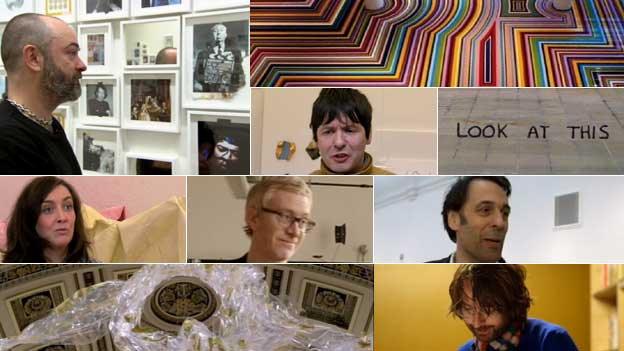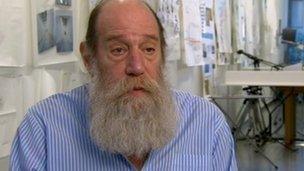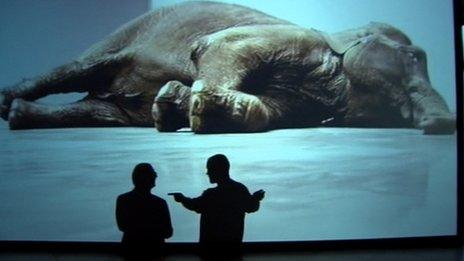How Glasgow conquered the art world
- Published

Douglas Gordon (top left) with Jim Lambie, Karla Black, Martin Boyce, Richard Wright and Simon Starling are just some of the Glasgow-based contemporary artists
It was described by art curator Hans Ulrich Obrist as the "Glasgow miracle". How has one city managed to produce a generation of international contemporary artists, scooping an incredible number of nominations for Britain's top visual art award, the Turner prize?
"Glasgow is a magnificent city. Why do we hardly ever notice that?" asks a character in Alasdair Gray's Lanark.
"Because nobody imagines living here," replies another.
"Think of Florence, Paris, London, New York. Nobody visiting them for the first time is a stranger because he's already visited them in paintings, novels, history books and films, but if a city hasn't been used by an artist, not even the inhabitants live there imaginatively."
Gray was writing in the late 70s and early 1980s when the former second city of the empire was reaching its economic and social nadir.
It was soon after this that a group of young artists began to forge a path which would take them to international acclaim and change the way Britain thinks about contemporary art.
The leader of this "Scotia Nostra" was Douglas Gordon - who was the first of them to win the Turner Prize, in 1996.

Martin Boyce with his Do Words Have Voices, based on a library desk
In the decade and a half between his victory and Glaswegian Martin Boyce picking up the 2011 prize, there have been a host of other artists with connections to the city who have been nominated or won the Turner.
Boyce was the third Glasgow winner in a row, after Susan Philipsz and Richard Wright.
Simon Starling in 2005 was another winner with a strong Glasgow connection.
Karla Black, Jim Lambie, Christine Borland, Cathy Wilkes, Lucy Skaer and Nathan Coley have all been nominated in recent years.
So what sparked this "Glasgow Miracle"?
One of the reasons was a new course at Glasgow School of Art led by David Harding.
A group of young Scots - including Coley, Gordon, Boyce and Borland - were on the environmental art course in the mid-1980s.
They had a new vision of art which was not about painting or sculpture and it was not restricted to the studio.
Harding says the "context" for making work was as important as the work itself.
The course did not take place in the Charles Rennie Mackintosh-designed Art School building but in a partially-derelict former girl's high school around the corner.
It was a place the students could be a gang, says Nathan Coley.
Whereas Roderick Buchanan says there was a "definite Alice in Wonderland feel to the place".
Christine Borland adds: "It was this year of total anarchy and freedom and that's just what you want to be doing when you are 19. It was amazing."

Lawrence Weiner described the Glasgow artists as a "better class of yob"
David Shrigley, who also studied on the environmental art course in the late 1980s, is not a Scot by birth but he is by adoption, having lived in the city for 25 years.
He says Glasgow was a very prosperous city which took an architectural wrong-turn in the 1960s.
"Glasgow was not bombed that heavily during the war but you would be forgiven for thinking it was," he says.
"It was actually "bombed" by planning. They did far more than the Germans ever did during the war."
Shrigley thinks that this contributed to there being lots of empty spaces in Glasgow which could be used as studio playgrounds for the artists.
In the years after art school, Douglas Gordon was the leading light in Transmission gallery in Glasgow.
It was an artist-run space which they used as a laboratory and a showcase for the group's new ideas and energy.
Gordon says: "Transmission was super important. It was where I learnt about situationism, when I realised that performance art was a valid and important part of what was possible as a young artist."

Doug Gordon with his video installation Play Dead
Simon Starling, who won the Turner prize in 2005, was a member of the Transmission committee.
He says: "We had this great sense of confidence. That you could just get on the phone to your favourite artist somewhere in the world and invite and often they would come.
"So people like Lawrence Weiner, who was this super important conceptual artist turned up and made a beautiful show and gave a talk and drank whisky with us all.
"Those moments for young artists are so empowering and demystifying."
Lawrence Weiner says he talked to the Glasgow artists about how art could be integrated into the society and "remain art".
He adds: "It was a better class of yob than the west and north of England that I had been working in."
Gordon, who has a tattoo on his arm which reads "trust me" says: "I travelled a lot in the late 80s and early 90s and the idea was you just said to everyone 'go to Glasgow'."

Transmission was a gallery which allowed the artists to take control
It worked. And in the intervening years, the Glasgow School of Art has spread around the world.
But many of these international big-hitters are still based in the city which formed them.
Another Turner prize winner, Jeremy Deller, has never lived or studied in Glasgow but says he has made many connection with its artists over the years.
He says: "London is more difficult to work in. Glasgow is easier to work in. People are more up for it and there is more space. People are less jaundiced and cynical, I find.
"I think it is important to be curious and have a child-like interest in the world.
"They are not in London so they don't have this pull of the galleries. So they don't think they have to satisfy the galleries.
"It's quite a good thing to have a distance from the art market because it means you don't get influenced by it and you just do your thing."
<link> <caption>Imagine: Glasgow - The Grit and the Glamour available on the Iplayer</caption> <url href="http://www.bbc.co.uk/programmes/b01l1brw" platform="highweb"/> </link>
- Published1 May 2012
- Published6 December 2011